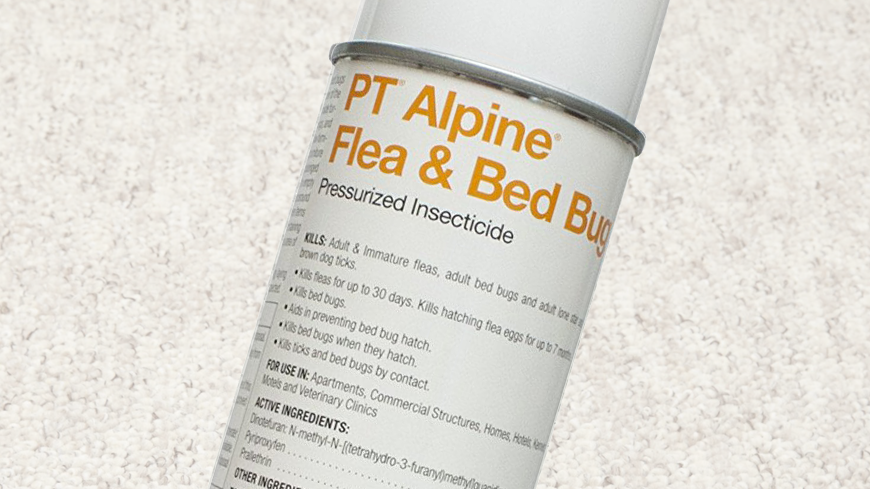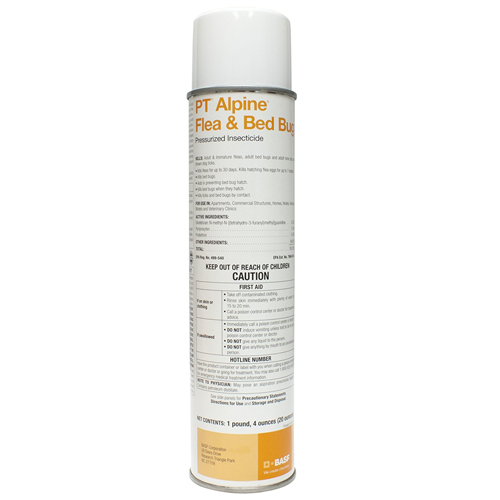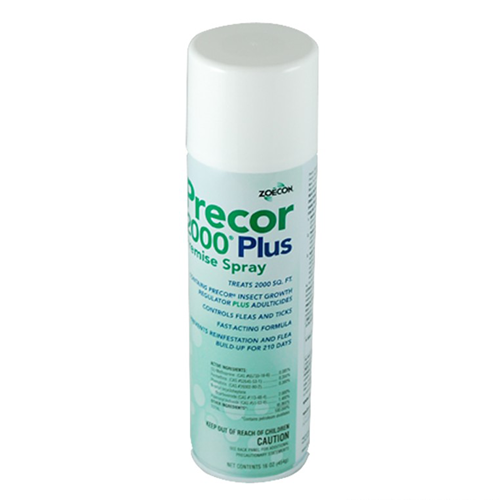Summary
PT Alpine Flea & Bed Bug is an insecticidal premise spray. It controls fleas, bed bugs, and ticks indoors. Dinotefuran and prallethrin are employed as adulticides to rapidly kill adult fleas. And pyriproxyfen prevents eggs and larvae from becoming adults. Pyriproxyfen remains active indoors for 7 months to prevent re-infestation.
PT Alpine
PT Alpine Flea & Bed Bug controls infestations indoors for 7 months.
Other premise sprays are similar to PT Alpine Flea & Bed Bug. There are slight differences, such as PT Alpine containing a neonicotinoid (dinotefuran). Still, performance should be comparable among top competitors. Focusing on price, Precor 2000 Plus offers the best value.
| Product name | PT Alpine Flea & Bed Bug Pressurized Insecticide |
| Active ingredients | 0.10% pyriproxyfen 0.25% dinotefuran 0.05% prallethrin 99.60% other ingredients |
| Target pest | Fleas, bed bugs, & ticks |
| Kills | Adults, eggs & larvae |
| Duration | 7 months |
| Size | 20 ounces |
| Capacity | 2625 sq ft |
| Application | Aerosol spray |
| Use on | Home premises |
| Manufacturer | Whitmire Micro-Gen |
| UPC | 804338140779 |
| Product label | view |
| MSDS | view |
| Shop | Amazon.com |
| Price | $25 |
| Customer reviews | Read reviews |
| Competitors | Browse premise sprays |
- Prices are based on Amazon.com at time of publishing.
Details
How PT Alpine Works
Pyriproxyfen
Pyriproxyfen, also called Nylar, is an insect growth regulator (IGR). It works by mimicking juvenile hormone (JH), an endogenous insect hormone that regulates development. When JH is present, insects remain in immature form. When JH subsides, it triggers the insect to metamorphose into an adult. IGR remains present when natural JH subsides. Thus it prevents immature insects from becoming adults. For example, exposed flea eggs and larvae never become adult fleas. In addition, exposed adult females and can’t lay viable eggs.
Pyriproxyfen is the most important flea control ingredient in PT Apline. This is because flea populations consist of 95-99% eggs, larvae, and pupae. These pre-adult stages live in the environment, often deep within carpeting. Insecticides can’t penetrate the carpet matrix to reach most of these fleas. As a result, the long-lived residual effect of IGRs plays a crucial role in their efficacy. Pyriproxyfen lasts 7 months indoors, preventing new eggs that fall onto the floor from surviving.
IGRs are more effective than traditional insecticides for flea control because of their longevity. Also, IGRs are also considered safer than conventional insecticides, because they mimic hormones that are rarely found outside of insects.
Prallethrin & Dinotefuran
The adulticides in PT Apline are prallethrin and dinotefuran. These insecticides quickly kill any adult fleas in the environment. Unfortunately, only 1-5% of fleas will be adults, and most adult fleas will be living on pets. The adulticides aren’t too effective on immature stages, because they can’t penetrate into carpets well and have a short-lived effect. After a few days pass, new emerging adults may not die. This is why adulticides are less important than IGRs for environmental control.
Prallethrin is a pyrethroid insecticide. It’s a synthetic derivative of pyrethrum, a natural insecticide produced by chrysanthemum flowers. The benefit of pyrethroids is that they’re synthesized to be more chemically stable than pyrethrum. Pyrethrum and its derivatives work by affecting the nervous system of insects, causing spasms, paralysis, and death.
Dinotefuran is a neonicotinoid insecticide. Neonicotinoids are chemically similar to nicotine, but are synthesized to target insect nicotinic acetylcholine receptors (nAChRs). The difference between nAChRs in insect and vertebrates is what makes neonicotinoids toxic to insects but relatively safe for humans and animals. Neonicotinoids cause hyperexcitation symptoms, seen as tremors, seizures, convulsions, and death.
Precor 2000 Plus
Precor 2000 Plus is slightly cheaper than PT Apline (may change).
Competitor Comparison
PT Alpine is similar to Precor 2000 Plus, Virbac Knockout, and Siphotrol Plus II. One slight difference is that PT Apline contains a neonicotinoid. Still, performance should be similar among top premise sprays. And Precor 2000 Plus is the cheapest option.
Instructions
The following instructions were taken from the product label of PT Apline Flea & Bed Bug Before using the product, view the label for the full directions and precautionary statements.
KILLS: Adult & Immature fleas, adult bed bugs and adult lone star and brown dog ticks
- Kills fleas for up to 30 days. Kills hatching flea eggs for up to 7 months.
- Kills bed bugs.
- Aids in preventing bed bug hatch.
- Kills bed bugs when they hatch.
- Kills ticks and bed bugs by contact.
FOR USE IN: Apartments, Commercial Structures, Homes, Hotels, Kennels, Motels and Veterinary Clinics
DIRECTIONS FOR USE
IT IS A VIOLATION OF FEDERAL LAW TO USE THIS PRODUCT IN A MANNER INCONSISTENT WITH ITS LABELING.
USER RESTRICTIONS
- Cover aquariums and fish bowls and remove birds from area prior to treating.
- Vacate areas to be treated and do not reoccupy or contact treated surfaces until dry.
- Do not apply in food/feed areas of commercial structures (i.e. food/feed handling facilities). In the home, cover or remove exposed food, in the treatment area, prior to application. Cover all food processing surfaces and utensils, in the treatment area, or thoroughly wash before use.
- Do not treat pets with this product. Treat pets with a product registered for use for flea control on animals in conjunction with this treatment.
PRODUCT INFORMATION
This product kills fleas and prevents flea infestations for a full season. Adult fleas may be seen in the treated areas when brought in on infested animals or when adults emerge from pupal cases; however, populations will not develop in the treated area. This product may also be used to kill bed bugs and ticks by contact, and aids in preventing bed bug hatch.
In transportation equipment, certain plastics may be whitened or dulled. Apply only to carpets and cloth upholstered areas, or test an inconspicuous area before treating.
NOTICE: This product has been tested on several types of carpet, fabric and other household furnishings without adverse affects. In a few instances, waxed surfaces have been whitened or dulled. Holding the can 36” away from the target surface normally prevents any whitening from occurring. Because of the wide variety of floor types and finishes, treat a small inconspicuous area before treating the entire area. Avoid contact with antique finishes.
APPLICATION INSTRUCTIONS
SHAKE WELL BEFORE USE! Use at the rate of 20 oz [one can] for up to 2,625 ft2 (10 oz [half can] for up to 1,300 ft2), applying in a sweeping motion at a speed of 1 ft/sec.
FLEAS: Treat infested areas, or potentially infested areas, including rugs, carpets, upholstered furniture, pet beds, pet resting areas, room edges, around and under furniture or other stored items. Hold can at arm’s length and direct spray toward the area to be treated. Use a sweeping motion to apply product and back away from treated area while holding the can 36” away from the surface being treated. An area of 80 – 100 ft2 can be treated in approx. 10 sec with this product. When treating upholstered furniture, treat under cushions and areas where flea development occurs.
BED BUGS: Kills bed bugs by contact. Apply where bed bugs harbor or are suspected of traveling. Treat the perimeter of the room at the wall/ floor junction, behind, under and/or inside furniture, upholstered furniture, head boards, wall coverings, and box springs. Do not apply directly to mattresses. Allow furniture and box springs to dry before use. When treating furniture (i.e. sofas and chairs), do not apply to areas with prolonged human contact. When treating luggage, apply only to empty luggage. Direct product into pockets, seams, folds and around wheels. Treat the perimeter of the area or room where items are stored. Allow surfaces to dry before use. Check for staining issues before treating by testing a small, inconspicuous area of the item to be treated. Reapply as necessary.
TICKS: Apply to infested nonporous areas and egg laying sites, or other nonporous areas where ticks are suspected.
STORAGE & DISPOSAL
Do not contaminate water, food or feed by storage or disposal.
PESTICIDE STORAGE: Store in a cool, dry area away from heat or open flame and inaccessible to children.
PESTICIDE DISPOSAL: Wastes resulting from use of this product may be disposed of on site or at an approved waste disposal facility.
CONTAINER DISPOSAL: Do not puncture or incinerate! If empty: Place in trash or offer for recycling if available. If partly full: Call your local solid waste agency for disposal instructions.
Tips for Success
Target Hot-Spots
Flea eggs are laid on animals, but they aren’t sticky and soon fall off. The eggs get widely distributed around pet habitats, but most end up concentrated where animals eat, sleep, and groom. Hot-spots in homes typically occur where pets lay down. In bedrooms, this may be at the side of bed. In living rooms, it may be beside sofas or around bed petting.
When using a premise spray, thoroughly treat the entire floor so there isn’t a gap in insecticide coverage. Still, give special attention to potential flea hot-spots. If a second or third treatment is needed in the future, spraying can be limited to identified hot-spots.
Have Realistic Expectations
There is no flea control product or method that will end an infestation immediately. The bulk of infestations are immature stages living in the environment. They reside in protected refuges where spraying and vacuuming removal is difficult. As as result, patience is required. The infestation won’t be completely over until all of these current fleas mature, emerge, and die as adults. However, once they do, they should be the last generation. New eggs falling onto the IGR-treated carpets won’t survive. Eradication usually takes at least 8 weeks. It’s not uncommon to see new adult fleas here or there until then.
Pre-Emerged Adults
Upon maturing, adults can choose to stay inside their cocoons, entering into a quiescent state for up to 5 months. The extended longevity of cocooned adults can cause control issues. One way to deal with these stages is to vacuum regularly. Heat and pressure on the cocoons triggers the fleas to immediately wake up and emerge. Vacuuming can simulate these host cues.
Vacuuming Procedure
Vacuum carpets prior to spraying. Vacuuming will lift up the carpet fibers, allowing the spray to penetrate deeper. Don’t vacuum again until the insecticide is dry. Then a regular vacuuming routine can be established. Vacuum at least every other day. Studies have shown that vacuuming shouldn’t reduce the efficacy of flea insecticides. Vacuuming may actually help, because it causes cocooned adults to emerge into the insecticde.
Premise Sprays Aren’t Enough
Adult fleas account for 1-5% of infestations and live on pets. They won’t leave a host once they jump onto it. Thus, spraying the environment isn’t enough to end an infestation. The adults will continue to live and mate on untreated dogs or cats. Each female lays around 25 eggs a day. If any eggs fall onto an untreated surface, then the infestation will continue.
This is why integrated flea control is best. Treat pets, treat the environment, and establish a regular vacuuming routine. This kind of regime will establish control quickly, and it will maintain control until total eradication.







You must log in to post a comment. Log in now.